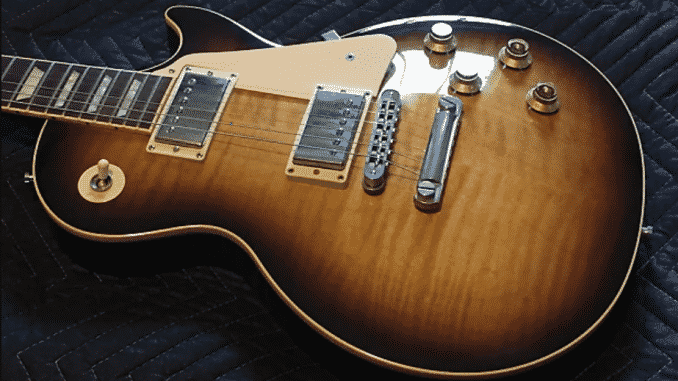
An interesting debate was brought before our attention and felt we should pass it along to you good folks. How does the Gibson Les Paul compare to the Epiphone Les Paul when Epiphone is owned by Gibson Brands, Inc. (formerly Gibson Guitar Corporation)? Let’s put your mad guitar knowledge to the test! Please feel free to comment at the bottom of this comparison review!
Gibson Les Paul and the Fender Stratocaster are, without doubt, the most iconic solid-body electric guitars since their invention.
The legends, Mr. Les Paul and Mr. Leo Fender were in a ‘friendly’ race to develop the first solid-body electric guitar to the public. Without their ‘rival’ back in the mid-to-late 40s, through the mid-50s, there may not be the influential Les Paul solid-body electric guitar, at least not how we know it today. Had that been the situation, perhaps we would not have these iconic Les Paul rockers such as Peter Frampton, George Harrison, Jimmy Page, Joe Perry, Ace Frehley, Zakk Wylde and Slash among others.
At first glance, these two guitars appear quite similar. Some musicians might even have trouble distinguishing between the two. While each Les Paul looks almost identical, the major difference you will notice, aside from the logos being distinctive, is the characteristics in the winged-shaped headstock.
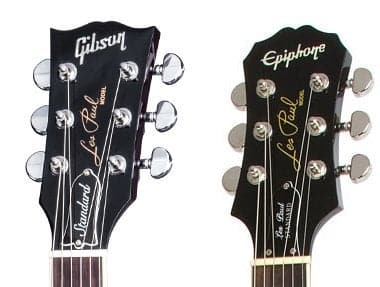
What’s the difference in Gibson and Epiphone Les Paul headstock? Gibson has the “Gibson” symbol and Epiphone as the “Epiphone” symbol embedded in the headstock.
Gibson has more of an outward arch that goes sharp up the sides for pointy edges. Whereas, Epiphone has more of a droop headstock with a rounded contour in the middle with the sides trimmed off, giving each headstock a distinctive winged-shape style. Each respective headstock is patent to the parent company; Gibson Brands, Inc.
Gibson Les Paul Compared to the Epiphone Les Paul
Gibson can cost as much as seven times higher than the Epiphone Les Paul. The instrument on the left is perhaps the most recognizable guitars in the guitar community: the Gibson Les Paul Standard.
You can purchase a Gibson Standard for around $2,500- $3,500. Pictured just to the right of the Gibson is the Epiphone Les Paul Standard, which clocks in at $499 (or $599 for the Standard PlusTop Pro). Now we recognize that Epiphone is Gibson’s junior brand (not to be confused with the Gibson Les Paul Junior).
To settle this issue once and for all, we’ve done some investigating to determine what the variations between these two are. Whether or not that difference is worth the extra two grand. To do this as fair as possible, we’ve made an attempt to avoid subjective statements (i.e. “but the Gibson just feels better”). Instead will be taking a look at the hardware of these two guitars. So without for ado, let’s dive into the varied world of the Les Paul. There are a few points of discussion that will hit along the way, including:
- Video – Can you tell the difference between the Gibson and Epiphone?
- Guitar Aesthetics – The Actual Design of the Guitar
- Tonewoods – What the Guitar Is Made Of
- Finishes – How the Guitar Is Protected
- Pickups – When Electronics Come Into Play
- Phase Control and Bypass Capabilities – Some More Electrical Variations
- Business Branding – “Only a Gibson is Good Enough”
Guitar Aesthetics – The Design of the Guitar
Let’s begin this investigation by inviting you, the reader, to examine the infographic image above. But this time, pay attention to the aesthetics of the guitar. As you can see, most of the stylistic touches between these guitars are nearly identical.
Both feature the classic four knob control system with 22 jumbo frets marked by the classic Les Paul trapezoid inlay. Both Les Paul guitars each sport similar pickguards, Grover Locking Tuners (on the Gibson Standard), and classic Grover Tuners (on the Epi), and Tune-O-Matic a bridge — though Gibson will implement higher quality hardware. Both guitars finish with somewhat not-so-similar headstocks. If we choose just to examine the visual similarities between these two guitars, you’ll find them to be quite similar. Although seemingly similar, these are not the same guitar. The most striking distinctions between these two guitars are:
Tonewoods – What The Les Paul is Crafted From
Both Les Paul features a thin, 60’s style mahogany neck with rosewood fingerboards. Each instrument’s underbody is crafted from mahogany wood. These instruments vary when it comes to their top material. The Gibson Les Paul is constructed from 3/4 inch flame maple wood. The nitrocellulose finish adds a nice touch. Conversely, the Epiphone uses a maple veneer and standard gloss finish. What this boils down to is different crafted tops make notable variations in each guitar’s tone really impacting your sound.
FYI, random but relevant information: veneer is created by gluing a multitude of thin sheets of wood together. While this creates a product that is less likely to crack, it seems to slightly alter the dynamics and removes a bit of the lower mid warmth.
Since the maple top and the tone associated with it is one of the most ICONIC parts of the classic Gibson Les Paul. This point of contention seems to indicate at least one area where Gibson’s Les Paul is demonstrably better than its Epiphone red-headed step-child. However, wood is only as good as its protection, and as you may know, these two guitars have unique finishes…
Types of Finish – How the Guitar Shines
We touched on this in the previous paragraph, but there is a huge contrast between these two types of finishes.
Gibson’s Les Paul uses a nitrocellulose finish which painstakingly applied via spray to the guitar (the fumes are toxic to breathe).
Despite the hassle, when applied properly, nitrocellulose finishes are very thin, allowing them to create a minimal impact on the vibrations of your guitar body while playing.
The Epiphone’s standard gloss is roughly analogous to what you might find in your local hardware store. It’s easy to apply and protects your instrument well, but must be applied thicker, reducing the guitar’s ability to vibrate. This can lead to some changes in tone, though these changes won’t be as noticeable as the differing pickups…
Gibson vs Epiphone Pickups – When Electronics Come Into Play
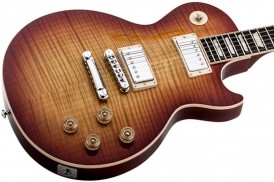 Although a bit difficult to see in the picture, these two guitars differ in their choice of stock pickups. The Gibson Les Paul features their standard BURSTBUCKER alnico humbucker pickups; Epiphone instead created the PROBUCKER alnico humbucker as a tribute to the classic BURSTBUCKER.
Although a bit difficult to see in the picture, these two guitars differ in their choice of stock pickups. The Gibson Les Paul features their standard BURSTBUCKER alnico humbucker pickups; Epiphone instead created the PROBUCKER alnico humbucker as a tribute to the classic BURSTBUCKER.
The PROBUCKER is a cheap adaptation of the BURSTBUCKER (which is just a lower end interpretation of Gibson’s PAF pickups). Both of these humbuckers boasts the same materials and wiring. However, the PROBUCKER has a particular connection type, with four simple input connections. — This makes it easy for inexperienced players to work on their pickups, but does reduce the sound quality of the pickup ever so slightly. It should be noted that the PROBUCKER pickups only come on the Epiphone Les Paul Standard Pro. The lower end Epiphone Les Paul’s do not feature as nice alnico humbucker pickups. In all, the BURSTBUCKER pickups score another point for Gibson.
Now say PROBUCKER / BURSTBUCKER 3 times fast. Go ahead, we’ll wait
Gibson vs Epiphone Electronics – Phase and Bypass Capabilities
Another area of disparity between these two guitars is the addition of new controls to the Gibson. The Epiphone only features the standard 2-tone, 2-volume controls, and the pickup selector, Gibson’s take adds in phase control and true bypass capabilities. This allows for a professional quality recording that will be in phase and contains minimal noise and static.
It almost seems to highlight the fact that Gibson wants their instrument to be viewed as professional quality, as opposed to the entry-level Epiphone. Gibson’s line of thinking might be on to something… business branding.
Gibby vs Epi Overall Craftsmanship – American vs Import
The biggest dissimilarities between these two instruments, with Gibson crafted in the United States, specifically in the “Music City” — Nashville, Tennessee since 1974, and Epiphone in China since 2004.
Gibson handpicks all the best tonewoods to build their instruments and only uses the highest quality of materials during the assembly process. The final magic comes from the amount of time they put into sanding and smoothing the neck, rounding and buffing the frets, and making certain everything is absolute perfection. Gibson guitars will always look nicer and play better than Epiphone! These instruments are a work of art.
Nashville Gibson Factory is known as the “solid-body mecca“ of the world. The Factory has around 500 employees and their employees stay with the company forever. Gibson does not have a high turn over rate due to the pride put into their instruments and how well Gibson treats their craftsman. Suffice to say, Gibson guitars are well-built and finished in utmost detail, including each guitar being professionally setup by a qualified Gibson technician before it leaves the factory.
Epiphone Les Paul’s are currently made and imported from China, and they do fine work. Their quality holds up and the instruments they send over the seas to us are excellent. The wood quality, electronics, and finish are where you will see the disparities when you conduct a hands-on, side-by-side review — and as the audio samples at the end of this page will allow you to hear the difference.
As for playability, you won’t find too many complaints. Epiphone’s quality control is not as strict as their mac-daddy, Gibson. Epiphone stands behind their product and sees to it they put a quality guitar in their customer’s hands. In most cases, any good brick-and-mortar guitar store will make certain the guitar is setup correctly before it leaves the store. Purchasing online is more of a crapshoot, but I’ve always had good luck.
Gibson Les Paul guitars are crafted whereas Epiphone Les Paul guitars are made.
Branding – “Only a Gibson is Good Enough”
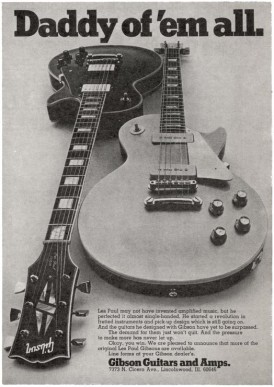
In all, it’s pretty undeniable that Gibson seems to have all-around better hardware, which shouldn’t come as a surprise. However, even after this review, we are still not sure the qualities between these two are around $2400 simply due to hardware, finish, and craftsmanship.
The powerful branding techniques, built on the legacy that IS GIBSON, are behind this pricing conundrum. After all, each of these guitar manufacturers both need and want to make large stacks of cash.
While Gibson is undoubtedly the better guitar in terms of construction, chances are that much of the price discrepancy is related to branding. Think about it… Gibson knows that Les Paul is its most popular model on the market. It is arguably the most influential model of any brand of guitar!
Due to the laws of supply and demand, as Les Paul became more popular, the prices of their higher and lower-end models have polarized. Their more expensive, professional-level guitars have only increased in price, while their bottom end Les Paul (Epiphone) has become more accessible at a significantly lower price.
This stratification has created enough space in the market for two players, Gibson and Epiphone. So long as one remains a high-end product while the other is lower end, the two facets of this company won’t cannibalize each other’s sales, leading to maximum profits for both.
When Gibson began pricing their Les Paul, they chose a value that would maintain their notoriety, while remaining accessible for a specific type of consumer ($2,500 isn’t too painful to spend when playing guitar is your profession). Gibson’s branding might explain the discrepancy in price between these two guitars; a difference so great that can’t be justified by better hardware alone.
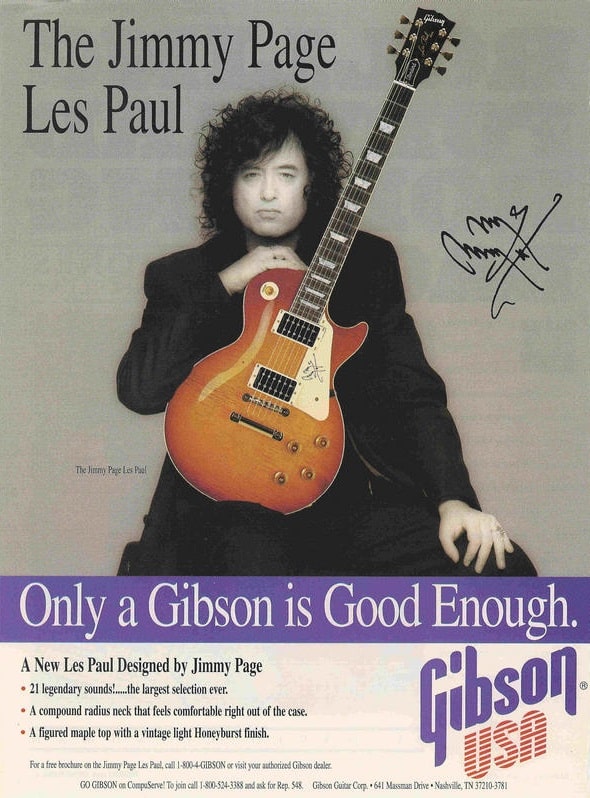
In reality, the discrepancy in price between these two is a combination of the following: branding, consumer perception, the actual physical hardware and construction of the guitars.
We hate to say this, but for the sake of journalistic integrity, we must: We don’t think the price discrepancy between these two guitars is fair. Sure, we might understand the reasoning behind this contrast, but that still doesn’t convince us that Gibson is worth all $2,400 of those extra dollars.
Epiphone vs Gibson Audio Comparison
Now for the fun part of this Comparison! Listen close to each unrevealed Les Paul playing in the sound sample for a blind comparison in the audio sample below. In total, there are three well-recorded tone samples; clean, crunch and high-gain.
First up, each guitar is played in the neck position on a clean amp setting, as you can hear in the audio sample, the first guitar (Guitar A) has more volume and a more chime, whereas the Guitar B is a bit more-crisp with the mids and less volume output.
Moving on to the crunch setting on the amplifier, playing through a JCM 800 sim — Guitar A is much brighter and has more attack, Guitar B is maybe a bit more dark, not as much treble — though not muddy.
Finally the high-gain amplifier setting! In this example, Guitar A has a slight bit more crisp-ness sound and more bass, more scooped. Guitar B is again, more dark with more mids.
The Audio Sample Reveal: Which Was The Gibson and Which Was The Epiphone?
- Clean setting, neck position
Guitar A = Gibson Les Paul
Guitar B = Epiphone Les Paul - Crunch channel, bridge position
Guitar A = Gibson Les Paul
Guitar B = Epiphone Les Paul - High-Gain channel, bridge position
Guitar A = Gibson Les Paul
Guitar B = Epiphone Les Paul
I’m sure your keen ear could notice the output and tonal characteristics between the Gibson Burst Buckers and the Epiphone Pro Buckers. You could tell the Burst Buckers have more output and the Pro Buckers have more midrange but are more-dull.
How thick is the maple top on a Les Paul? Another contributing factor to the brighter sound on the Gibson Les Paul is the 1/2 to 9/16 -inch maple top, whereas the Epiphone Les Paul is veneer 1/4 -inch. Maple tonewood is a brighter sounding tonewood.
Gibson vs Epiphone Final Summary
- Guitar Aesthetics – Slight Variation of the Headstock
- Tonewoods – Maple Wood vs Maple Veneer
- Finish – Nitrocellulose Finish vs Standard Gloss Finish
- Pickups – BurstBucker vs ProBucker – Gibson Les Paul is brighter sounding. Both are alnico humbuckers
- Electrical Characteristics – Phase Control and Bypass Capabilities vs Standard Controls
- Business Incentives – American Made vs China / Overseas Made
- Price discrepancy – Ouch!
If you hate our analysis, then we’d love to hear from you in the comment section below. If you agree, we also want to hear from you too!


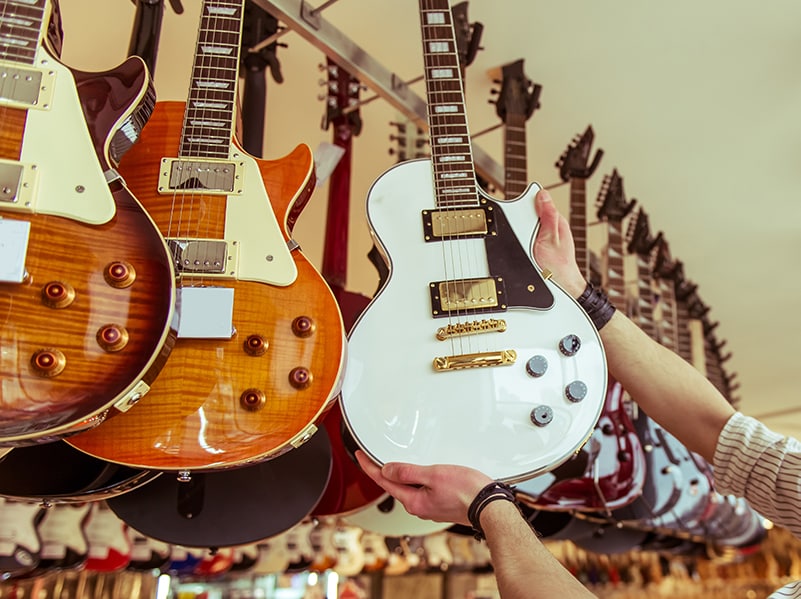

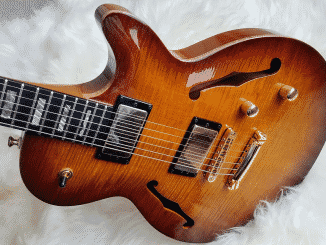
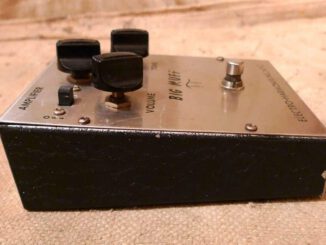
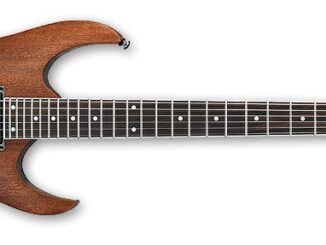
Les Pauls have always been overpriced, you can get a better looking, better sounding and better quality guitar for less from PRS. Additionally, you can take the above Epiphone and spend a couple hundred bucks on upgraded hardware, upgraded picks and add the missing circuit and you will have an Epiphone that sounds exactly like the Gibsonfor a 1/4 of the price. But even then your true Gibson lovers will say with their noses high in the air, “My Gibson is still a better quality and better sounding instrument”… I’m a collector and a player and I own Gibson’s, Epiphones, PRS’s and some incredible boutique guitars that put all the big boys to shame… The one thing I have learned, each and every single guitar has it’s own unique sound and qualities, even between guitars of the same make and model. And now with all the modern manufacturing processes that every manufacturer shares, the differences between an Epiphone and a Gibson is not as far apart as the price and the hoopla the companies want you to believe.
Oops… That was supposed to be “pickups” not “picks” in my above post. And for all you grammar police types, some of the other errors were caused by auto correct from my phone so relax and save your breath for giving us your opinion on the article above 🙂 🙂
Both great giutars but looking at this years models the build standard has dropped a little. Would I buy one? So much choice all at very good prices. A hard choice.
I can hear a definite difference, guitar A sounds brighter & clearer than guitar B. That being said, Many Epiphone guitars, particularly higher end guitars, are a great value. The lower end guitars appear to be pushed out quickly w/ little regard for QS in the hopes that new guitarists can’t tell. I received an Epi acoustic electric as a gift, had to send it back because the neck was unplayable, & although it was obvious that Epiphone US had done more setup & finish work, I’ve still put over $100 into a $500 guitar to make it playable all over the neck. I’ve also played Epi SGs & LPs that were purchased for beginning guitar players that were very feasible after some minor setup & fret work.
As w/ many tools of many trades, you get what you pay for, but I have to agree that Gibsons tend to be over priced for gigging guitar players & many of the newer models seem to be produced for collectors of expensive things rather than actual guitar players.
Thank God for Epiphone! I own three Epiphones now including a Les Paul Custom Ltd Edition. I am so pleased with the axes I have bought in the last 4 years…they should almost charge more for the Epi’s (but don’t tell them that). I love some of the newer Gibson models and have always been a fan but the price has been out of my range regarding the top end Les Pauls and such.
I think the quality control team in China is doing a pretty fair job and are putting out good guitars for the price. Just about to order a new Epi ES-335 Pro…always look for the Epiphone Custom shop logo (back of headstock) on some models and you can’t go wrong. I’m not sure of how the value will hold up over the years but I play my axes and don’t plan on selling them. The Les Paul tribute guitar is fantastic by the way with the Gibson pickups and case included for $599.00
I do believe playability is an important aspect for consideration. From my experience lower end imported guitars often are stiffer in general and harder to bend . . . . I mean these as two different characteristics. I wish Washburn still made the Idols with the Custom Customs and the 59s in the neck because they blow Gibson pickups away in most if not all instances. I’ve never played one; but I do have a Washburn V with those pickups and it’s an ugly guitar that plays like melted butter and sounds like a 59 LP. I’m a hobbyist and lazy so, I play sitting down. That being said. I think single coils work better with many ods and fuzzes so, Fender Baja Player Tele in Swamp Ash is my main practice guitar. It wounds beautiful clean and beautiful with pedals plus, the s-1 switching system gives you tonal options that with one or two pedals you can cover anything and your owns stuff!
@don That’s exactly what we’re saying, thanks for the comment. Seems like when most upper end players will be changing a lot of the hardware anyways, there’s really not too much of a reason to instinctively go for a Gibson over an Epiphone. They really aren’t too different (other than price, of course).
@J We totally get that. It really comes down to the fact that every guitar is different, even the same makes and models. Plus, people have different preferences. Sorry to hear about your Epi experience though, hopefully you got her in good shape in the end.
@Raven Hope you enjoy your new axe! Also, that’s a good tip to look for the Epi Custom Shop logo. People need to know what they’re getting.
@ron Playability is absolutely the most important aspect when picking your guitar. However, because playability is so utterly subjective and varies greatly even within the same makes and models, it’s not really something we can use to fairly compare the two guitars. We’re pretty jealous of your Fender though, it sounds like a pretty nice guitar.
There are big sound differences between the two guitars,and using a digitised youtube clip to compare them is pointless as you have to be in the same room as the gear to hear the real sound(which is of course better).
I had an epiphone once and loved it.I upgraded the pickups and electronics and felt like Jimmy Page.
Then one day i tried a proper Gibson and Japanese Tokai love rock.Both these guitars ate the Epiphone alive and now i really did get that pro sound i was always looking for.
Sure the Gibson is overpriced,but you also have to consider the cheap metal on the epiphones that eventually is worn away and snaps your strings alot.
Whereas the Gibson is designed for the road with better hardware.
Jim, I get what you’re saying. However, if both guitars sound almost equally as good through a cheap YouTube recording (though I do think the Gibby sounds slightly better in the video), but in order to hear the ‘true’ sound difference when requires sitting down and A/B’ing them side-by-side, does that justify the $2,500 price hike?
As for the string breakage, I never had a problem. But I know a TonePros bridge system can be purchased pretty damn cheap. Or you can buy a used Gibson bridge off ebay for a fair price… that solves that problem (if it’s even a problem).
At the end of the day, I think the difference in price is mainly the logo on the headstock among the few other difference, which Jack highlighted in his comparison.
guitar b is not nearly as good probably the epi
I had an entry level Gibson les paul mahogany with burstbuckers 1&2 . . . . it was good, but the Duncan custom customs and 59s sound better. Originally, these burstbuckers were made for japan les pauls and because they gave feedback better were finally made for the US. However, almost all models have burstbuckers 2&3. They did give a great vintage sixties sound for like Cream, etc. I thought I liked the shorter neck length – 24.75, but now I’m using the longer 25.5 all the time and it’s no problem. The new 61 zebra humbuckers on the low end SG look great, and I can play it sitting down as a hobbyist, but I hear SGs suffer from a heavy neck if you play standing up. However, I used pedals a lot more and I don’t feel I need the heft of humbuckers like I used too.
Here is Henry’s view on the subject, CEO for Gibson. Borrowed from the Gibson forum on their website…
“In any case, our Epiphone Les Pauls, are real Les Pauls. Our plant manager in China was the plant manager in Nashville for a number of years and all our divisions work together to get the very best product for the price. Most Les Paul’s come from our own factories in Quing Dao China and I believe they are superb instruments and great values. They do say Epiphone and our customer know what they are getting for their hard earned money.
Are the Epiphones as good as Gibsons? They are not the same. We try to make guitar affordable at Epi so the material and construction is different. The tops are typically laminated and the wood is a specie called Nato. There are other subtle differences. Both are great instruments, but they are not the same. I think they are both great values and both are professional quality.
I think what you believe is a lot more important than what I believe.
Thanks for taking the time. Henry “
I guess the point I was making is that if you want a USA Gibson, then the Mahogany or what they call the SGJ or LPJ models are priced a bit on the lower end between a Gibson and an Epiphone. You seem to have an option of the new 61s or 490s for pickups.
While there are construction & materials differences between the two, by changing hardware & doing additional setup & finish work on an Epiphone you can still get a gigging axe for a lot less than the equivalent Gibson. Tweaking the neck, refinishing the frets, routing the bridge & adding a new saddle increases the cost of my new Epi acoustic, but I have a very playable guitar for half to a third of the cost of a Gibson. I also have two early 80s guitars made in Japan, one of which is an Epi, that are as good or better than the equivalent Gibsons of the same period.
The issues I have are two:
many of the newer Epiphones are made to quickly put them out, QS is poor & many of the places selling them don’t do setup & don’t seem to care about the quality. They’re made for entry level guitars players that don’t & may never know the difference.
Gibson is producing some very nice guitars, but @ the price points appear to be producing guitars for collectors rather than guitar players.
I will freely admit I didn’t play any Gibson LP’s before making my purchase of a Epi LP 1960’s Tribute Plus a bit over two years ago. Why? It was pointless, I wasn’t going to spend the $2.5K anyway no matter how good it was.
One point…many Epi LP’s have a solid maple cap with the veneer over that, so the difference there is less than it may seem.
My Tribute Plus is equipped with Gibson ’57 Classics, Grover locking tuners, a few more buzz words AND a hard shell case, so there go a few more differences.
Now for the REAL kicker. Just over two years ago, on sale I paid $500.00 plus tax.
I would jump at the chance to play it side by side with a comparably equipped Gibson. For the Gibson money I could have also gotten a Vox AC30 and about 5 good pedals.
No, I’m not a pro player but I see no reason my Epi shouldn’t last the rest of my life plus.
I’d take a higher end Epi ANY day over a low end Gibson.
My yellow Epiphone LP Special 1, after a setup; and fret board honey application has a really good “feel”, to me. I play it more than my Gibsons…bolt on neck and all.
For $130.00 whats not to like ?” The instrument plays like “buttah”, looks like butter, fast neck, raunchy tone…great guitar for the $$.. I’ll take 20 over 1 Gibson LP 🙂
I’m totally surprised, this has to be the first time I have been in a discussion concerning any guitar vs Gibson where Gibson diehards haven’t come on and beat up anyone not praising their idol. Now that is refreshing 🙂 🙂
one thing you did not mention is that it is rather easy and not that expensive to upgrade your epiphone by replacing the stock electrical parts with the gibson ones and then you have a seriously amazing sound for a lot less money i changed my epiphone lespaul classic to gibson 496r for $89.95 500t for $89.95 4 gibson 500 ohm potentiometers at $9.99 each and 2 orange drop capacitors for $33.95 for both for a total investment of $256.00 add that to the original $449.00 and that is a total investment of $705.00 and yes it sounds just as good as its gibson counterpart for 1/3 the price
Talking about the tone woods. I’m wondering if the Epi LP 1960 Tribute Plus is closer to a Gibson sound since it has a maple cap under the maple veneer. Also it comes with Gibson 57 Classic pickups. Are those PAF’s?
I got a 2014 Gibson SGJ, cheaper than some Epiphones, and the ’61 Zebra pickups do sound really good. When it comes time to change the strings it does need some setup work but the materials seem good quality. It’s the loudest solid body guitar I’ve played unplugged.
I think if you can find an Epiphone that fits you, that you like to play and can play easily, changing the electronics will get you a good guitar. The neck, string height and body feel are important, Seymour Duncan can take care of the rest.
I have a Gibson Melody Maker (P 90s) and an Epiphone LP Studio (Alnico Humbuckers). The Epi is a much better made guitar with better tuners (Grovers), humbuckers, nicer headstock, and plays like butter. The Gibson is a good guitar too; maybe it is the pickups, but it just doesn’t play as well. Both have Mahagony bodies. The Gibson has a Maple neck, while the Epi has a Mahagony neck. Both have rosewood fretboards. Yes, the tones are different. Tone (for me comes down more to pickups, amps, and strings. The Gibson was around $500 and the Epi was $200 (used, but in perfect condition). I happen to like the Epi better. I have been playing over 10 years.
These threads are like the Apple vs. Windows computers or iPhone vs. Android phones. All are good stuff, just all a matter of opinion.
I have one of each. The Epiphone Wildcat and the Gibson Les Paul Studio. Here are some clarifications about this discussion. Gibson “could” be a more expensive guitar. There are affordable Gibsons. I got mine for 800.00 brand new on clearance in perfect condition. It came with a hard shell case that alone was worth 200.00, it is gold with locks and the most beautiful guitar case I have ever seen. That alone makes me feel that I am spending only about 600 on my guitar which equals out in price to higher end model Epiphones.
Here’s the other issue. Notice through this discussion, as many compare the two, they use the word “different” more than “better” or “worse”. That’s because they ARE different and they each actually have better and worse specifics about them. How is a Epiphone better? I have seen much more creativity in the designs of Epiphone than I have of Gibson. Gibson wants to take the initiative to stay original and doesn’t take as many risks with their change, although their last major change was a big risk and an overall failure (the electric tuners).
This was a good idea for Gibson though and I give them credit for trying very hard to make it successful. It started with the minituners and when complaints arrised from these, they went to an advanced Gforce tuners. These tuners are impressive at first sight and brought new options to the tuning head world. However, it brought complications as well and it Gibson did not realize that most guitarists are stuck on the manual functioning of tuning heads (the looks, the feel, etc.)and it was not a concept that guitarist want changed. The smart move Gibson did with this is putting them on their lower priced guitars and made it very easy for a guitarist that wants manual tuners to change them out, which is a common procedure for guitarist.
One more advantage of Epiphone; from my experience, Epiphones are better jazz guitars. I’ve played a few jazz tunes on less pauls and sg’s, but none could match the warmth of my epi wildcat and my wildcat has no upgrades, it is a semihollow though, and comes with a bigsby trem. A semihollow Gibson with a trem would be thousands of dollars more. I don’t doubt that it would sound better and last longer, but you would have to buy a least 4 wildcats before you could match the price of a Gibson that is semihollow AND comes with a trem. I doubt the Gibson would be worth the price difference. It should not be more than a thousand dollars in price difference. Then there are low budget guitarists like me who love to try new guitars constantly, but don’t have the money. Ephiphone makes this possible, worthwhile, and fun.
So how is the Gibson better? They do have the capability to satisfy. I have a friend with a Gibson semiollow that he has had since the 60’s, and you couldn’t pay him to change guitars. It looks like crap, but it sounds good. It’s all original except for strings, very corroded, but easier to play chords on. It is very “different”, but I have played it and have never caught an impression with the feel.
So why did I buy a Gibson? I tried several epiphones and gibsons under 1000 at the store one day, and the studio sounded and felt the best. I was comparing it with the Epiphone Emperor Swingster, which had a beautiful sound, maybe even better for jazz, but the feel for the studio caught me along with the beautiful case and I didn’t like that the Swingster only had 20 frets. The Swingster definitely looked nicer though. If I would have bought a case for the Swingster, I would have paid the same price.
All in all, the Gibson is a better guitar, but no where near several thousand dollars better. You can get an affordable Gibson though with careful extensive shopping. I think one caution to take with epiphones is that they have more of a reputation for disappointing people when bought online. I don’t believe their guitars go through as much inspection and they definitely go through more extensive shipping, so if you have to pay 50 dollars more for a guitar you could try out and feel DO IT.
Great post, thanks for sharing your experience!
This is so old idk if anyone will read it, but here goes.
I work on guitars for a living. I have held and played and tinkered with scores and scores of very expensive gibbys and very cheap epis and all in between.
As of right now, and i hate to say it, epis are better than gibsons. Period. Im talking about the high end epis here not the super cheapos.
The hardware is equal or better. The one place you would think gibson was superior is in the hand carved bone nut…but whoever is carving them these days sucks, and the bone is of poor quality. Soft and quickly worn down.
The finish on an epi is better. If you think nitro gives a better tone you know squat.
The fretwork is better. A new gibson lp has the feets ending short of the binding where the binding makes the edge of the fret instead of undercutting the frets. Pure garbage. After a short time of playing little notches wear out of the plastic with hideous results. Then you get to pay someone like me another 2 or 3 humdred bucks to refret you gobson the way they do the epis in the first place.
The setups are equal or better. I have seen many gibbys over 3 grand with pickups so high they hit strings and nuts so low open strings buzz.
Right now if you gave me a 3000 gibson, id sell it to some brand snobby collector shmuck, buy a couple of nice epis, and pocket 2 grand.
Minor correction: Les Paul was an artist that lent his name (and his input) to a guitar manufacturer. Leo Fender WAS a guitar manufacturer. The “friendly race” was actually between Leo Fender of Fender and Ted McCarty (with engineering genius Seth Lover) of Gibson.
My luthier friend explained it to me early on. “When the two of you first meet, you’ll either like each other and get along fine, or one of you will have issues with the other and you’ll probably part company. The price just doesn’t enter into it.” Gibson or Epi must be handled by the prospective partner. Granted, I have a different criteria than you, but, my experience has been that great relations can stem from cheap guitars.
Ok. I am an amateur guitar player. Recently purchased an Epi Les Paul 50s Gold Top. $599. Made in China in 2020. You could use a magnifying glass and not find any finishing flaws. I hope the same can be said of American made Gibsons. If I had the money I would have bought the Gibson just for patriotic reasons. However I couldn’t tell any difference between the 2 guitars sound. BUT, as I said, I’m an amateur. What do I know about sound. However I do have experience in getting sucked into Hi End Stereo speakers. The law of diminishing returns REALLY kicks in there. Buy a decent pair of say B & W speakers for a few hundred dollars and then try to chase Nirvana by spending thousands on the next ones and find yourself disappointed that the ones that cost a couple thousand more that you spent on the new ones don’t give you thousands of dollars better sound. I suspect the same applies to the Gibby Epi debate too. Especially in 2021. My Epiphone gold top is 10 pounds of beautiful guitar.
The Epiphones that were made in Korea are pretty awesome. I have several Epiphones made in Korea from the late 90s and early 2000s. The craftsmanship is amazing in those years, and in my opinion. As far as Epiphone China, I haven’t purchased one yet, but I’d consider that latest Epiphone 59 LP copy. I heard it’s truly right and magical.
The two guitars sound slightly different. Depending upon the song, I might favor the “brighter” Gibson or I might favor the “softer” Epiphone. But in reality, I can only hold one guitar while playing and spending time worrying about the small sonic difference…either way…doesn’t make much sense because I’ll enjoy the one I’m playing. For the price of the Gibson, I can have a good Epiphone, a good Squier, a good Ibanez, and…for good measure…a good used Peavey T60. A quiver for the price of an axe. To paraphrase Pete Townshend (remember him?):n “I call that a bargain, the best I ever had.” Rock on!
I will make a very quick comparison. Gibson has priced themselves into 500 million Chapter 11. Murphy Lab, Slash ad nauseum, Jerry Cantrell, and so on and so forth. Let’s rewrite this review with a comparison of the 2002-2008 Epiphone Elite(02-03) and The Elitist(04-08) just in the Les Paul mode. After seven(7) years Gibson shut the production down, except for the Casino. All the other models’ to include acoustics, hollow-body, SG’s and Artist models were made with solid woods and crafted in Japan by honorable, meticulous craftsman. I own 14, 11 LP’s and 3 SG’s. They are without a doubt, except for that God awful ugly “tombstone” headstock, FAR superior to any USA made Gibson. And they don’t cost a “small used car”!
Read this Non-Official Wiki page. The information that is incorrect would be the lack of proper dating on the 2002-03 “ELITE” series. After the initial first paragraph,, there are links to American and Japanese Market models. But, I am guessing that due to Ovation threatening to sue Gibson, imagine that, Gibson getting sued, so the Elite moniker is relevant to the first two years referenced and left out of this article.
https://web.archive.org/web/20170316084301/http://epiphonewiki.com/index.php/Elitist_Series
The new 59 Inspired by Gibson model has Gibson Burstbucker
2 & 3. Sounds like a keeper for me. I’ll be trying one out this weekend. On sale 749.00 but you get the Epilite case instead of the plush hardshell one resembling the original 59 case.
Thats OK with me.